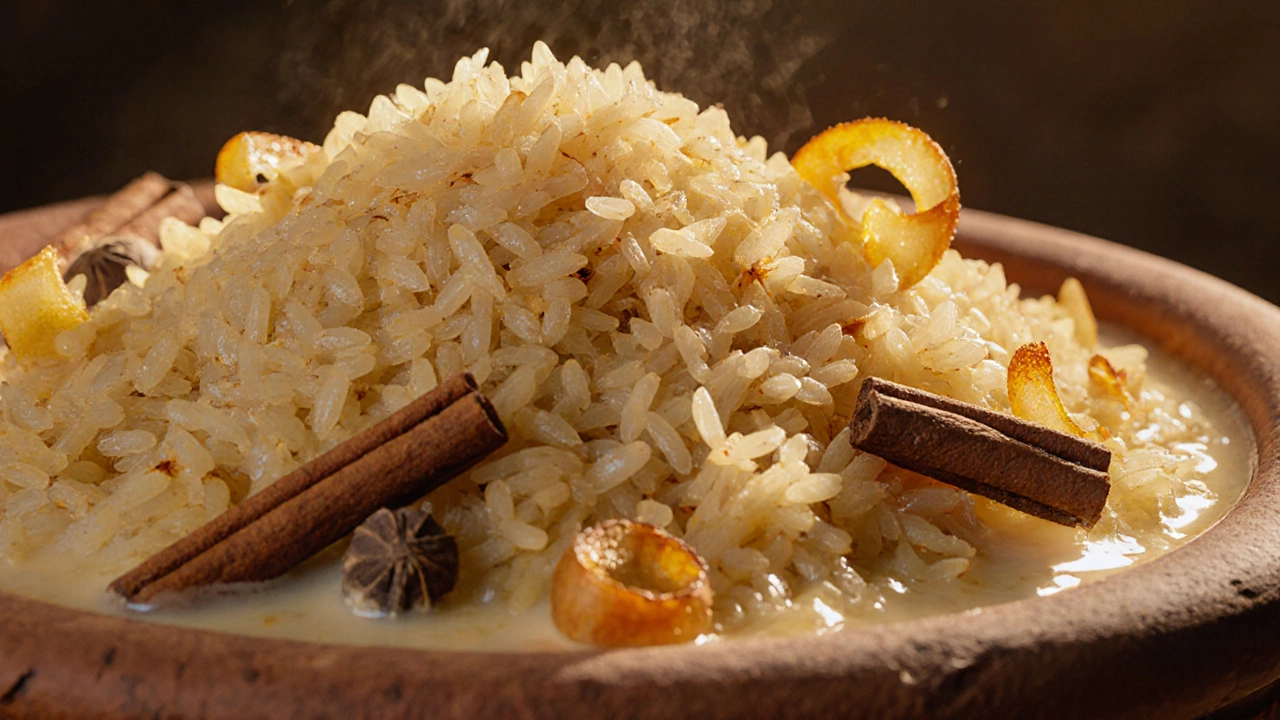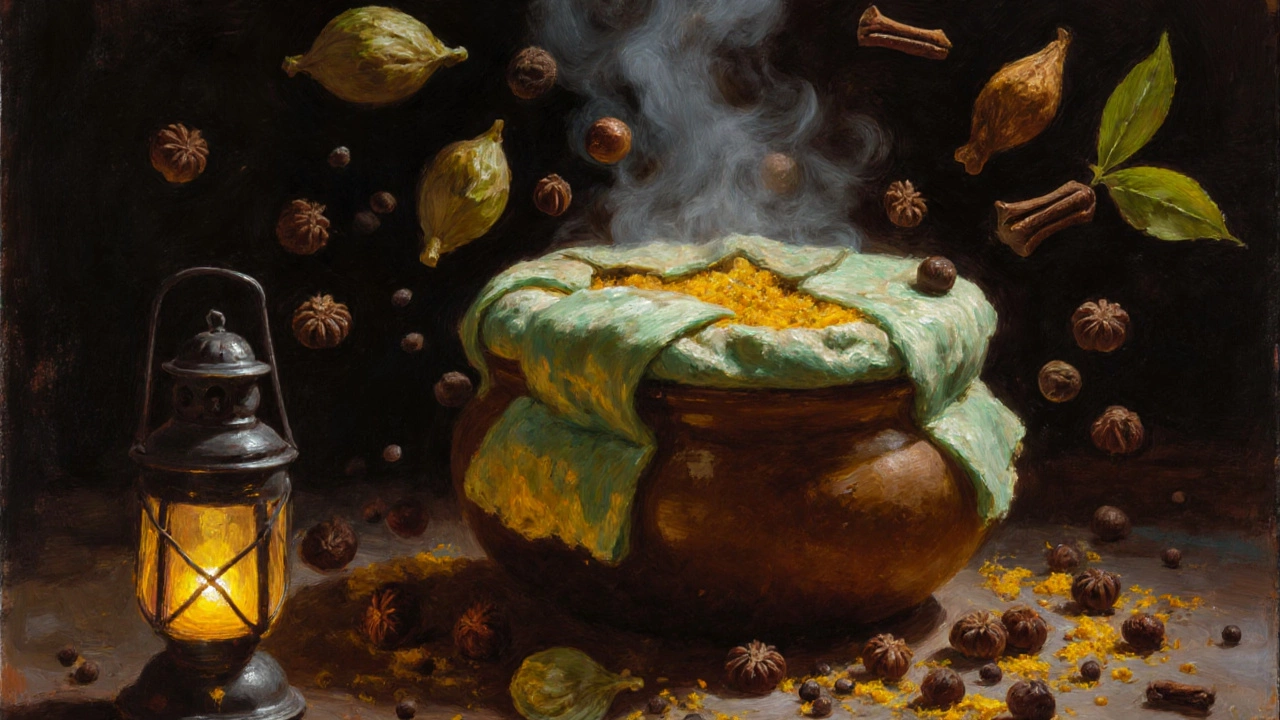What Makes a Perfect Biryani? The Real Secrets Behind the Best Biryani Recipe

Biryani Quality Checker
Check Your Biryani Technique
Enter your preparation details to see if you're following authentic biryani methods from the article.
Your Biryani Quality Assessment
Biryani isn’t just rice and meat. It’s a layered story-of patience, spice, and tradition. Every region in India has its own version, from the fragrant Hyderabadi dum biryani to the spicy Kolkata version with boiled eggs and potatoes. But what truly makes a perfect biryani? It’s not about using the most expensive ingredients. It’s about understanding the balance between each element-and getting the details right.
The Rice: Not Just Any Grain
The foundation of any great biryani is the rice. Basmati is non-negotiable. But not all basmati is the same. Look for aged basmati-rice that’s been stored for at least a year. Older rice has less moisture, which means it cooks up longer, fluffier, and less sticky. When you cook it, don’t boil it like pasta. Parboil it to about 70% done. The grains should still have a slight bite in the center. That’s because they’ll finish cooking in the dum-steam trapped under a sealed lid. If you overcook the rice at this stage, it turns to mush by the time the biryani is done.
Use 1.5 cups of water for every cup of rice. Add a pinch of salt, a whole cinnamon stick, and two cardamom pods. These don’t just flavor the rice-they help separate the grains. Rinse the rice until the water runs clear. That removes excess starch. Skip this step, and you’ll end up with clumpy rice instead of separate, silky strands.
The Meat: Quality and Cut Matter
Chicken, lamb, goat, or even beef-each works. But the cut makes all the difference. For lamb or goat, use bone-in pieces. The bones release gelatin as they cook, thickening the gravy naturally and adding deep flavor. Chicken thighs are better than breasts. They stay juicy under steam. Don’t trim all the fat. A little fat means more flavor and moisture.
Marinate the meat for at least 4 hours. A good marinade includes yogurt, ginger-garlic paste, turmeric, red chili powder, and a touch of lemon juice. Yogurt tenderizes. The acid breaks down proteins gently. If you’re short on time, 2 hours will work-but the flavor won’t penetrate as deeply. Skip the marinade entirely, and your biryani tastes flat.
The Spice Blend: Less Is More
People think biryani needs ten different spices. It doesn’t. The magic is in the balance. Start with whole spices: bay leaves, cinnamon sticks, cloves, cardamom, and black peppercorns. Toast them lightly in ghee or oil before adding anything else. That unlocks their oils. Don’t grind them. Whole spices release flavor slowly during cooking.
For ground spices, use just three: turmeric, red chili powder, and coriander powder. That’s it. Some add cumin or garam masala, but that’s a distraction. Garam masala belongs at the end, not in the base. Too many spices fight each other. A perfect biryani lets each flavor breathe. If you can taste the cumin over the saffron, you’ve gone too far.

Saffron and Rose Water: The Soul of the Dish
Saffron isn’t optional. It’s the soul. Soak 15-20 strands in 2 tablespoons of warm milk or water for 15 minutes. Drizzle this over the rice before layering. The color alone transforms the dish. It’s not just about looks-it adds a subtle floral note that lingers. If you skip it, your biryani looks like plain rice with meat.
Rose water? A few drops. Not for flavor, but for aroma. It’s like perfume for your kitchen. Add it to the milk you use for the saffron, or sprinkle it lightly over the top layer. Don’t pour it in. One teaspoon is enough. Too much tastes like soap.
The Layering: Technique Over Show
Layering isn’t decorative. It’s functional. Start with a thin layer of rice at the bottom. Then meat, then more rice. Sprinkle fried onions between each layer. Fried onions aren’t just for crunch-they add sweetness and depth. Caramelized onions caramelize the juices. They’re the secret behind the rich, sticky bottom layer called tahdig in Persian, khurma in Urdu.
Use fresh mint and cilantro between layers. Not chopped-whole leaves. They infuse without turning to mush. Add a few strands of saffron milk on top of each rice layer. Then seal the pot. Use dough made of flour and water around the lid. Or use a damp cloth under the lid and cover with foil. The seal traps steam. That’s the dum-slow cooking with no heat escape.
The Dum: Patience Is the Final Ingredient
This is where most people fail. The dum isn’t just cooking. It’s letting flavors marry. Cook on low heat for 30 to 45 minutes. No peeking. Every time you lift the lid, steam escapes. That’s moisture lost. That’s flavor gone. If you’re using a heavy-bottomed pot, you can place it on a tawa (griddle) to distribute heat evenly. Or put it in a preheated oven at 160°C. Both methods mimic traditional clay ovens.
Don’t rush it. If you’re cooking for guests, start the dum 45 minutes before serving. Let it rest another 10 minutes after turning off the heat. The residual heat finishes the rice gently. It’s like letting wine breathe. The flavors settle. The aroma deepens.

Common Mistakes That Ruin Biryani
- Using fresh basmati instead of aged rice
- Boiling the rice until fully cooked
- Skipping the yogurt marinade
- Using pre-ground garam masala in the base
- Adding too many spices
- Not sealing the pot during dum
- Opening the lid too early
- Using water instead of milk for saffron
One of the biggest errors? Trying to make biryani in a pressure cooker. Yes, it’s faster. But you lose the slow infusion of flavor. The rice gets uneven. The meat turns rubbery. Biryani isn’t a meal you speed through. It’s a ritual.
Regional Variations: What Sets Them Apart
Hyderabadi biryani uses kewra water and a lot of saffron. It’s rich, layered, and fragrant. Kolkata biryani has potatoes and boiled eggs-leftovers from British colonial times. Lucknowi biryani is mild, with slow-cooked meat and almost no chili. Malabar biryani uses short-grain rice and coconut milk. Each version reflects history, climate, and culture.
But the core stays the same: perfect rice, tender meat, layered spices, sealed steam. No matter where you are, if those five things are right, you’ve got a perfect biryani.
How to Serve It
Don’t stir it. Use a wide spoon to scoop from the top. Let the layers stay intact. Serve with raita-cucumber and yogurt with a pinch of roasted cumin. A simple salad of onions and tomatoes with lemon works too. No chutneys. No extra sauces. Biryani doesn’t need help.
Leftovers? Reheat gently in a steamer or microwave with a damp paper towel over it. Never reheat on high. It dries out the rice and toughens the meat. The best biryani is made fresh. But if you must, do it right.
Can I use chicken instead of lamb for biryani?
Yes, chicken works very well-especially thighs. They stay juicy during the long steam. Use bone-in pieces for better flavor. Skip breast meat; it dries out. Marinate chicken for at least 2 hours, and don’t overcook it during parboiling. The dum will finish it perfectly.
Is saffron necessary in biryani?
It’s not technically required, but it’s the defining element. Saffron gives biryani its signature golden color and subtle floral aroma. Without it, the dish looks dull and tastes flat. Even a few strands soaked in warm milk make a difference. If you can’t find saffron, skip it-but know you’re missing the soul of the dish.
Can I make biryani without frying onions?
You can, but you’ll lose depth. Fried onions caramelize and add sweetness that balances the spices. Raw onions turn bitter when steamed. If you’re short on time, use store-bought fried onions-but choose ones without preservatives. A quick fry in ghee takes 10 minutes and makes a huge difference.
Why is my biryani too dry?
You probably overcooked the rice before layering, or didn’t seal the pot properly. The dum needs trapped steam to finish cooking the rice gently. If the lid leaks, moisture escapes. Also, check your meat marinade-yogurt adds moisture. If you skipped it or used low-fat yogurt, the dish will dry out. Always parboil rice to 70% done, not 100%.
What’s the best rice for biryani?
Aged basmati rice is the only choice. Look for labels that say "aged 12 months" or "premium basmati." Brands like India Gate, Daawat, or Kohinoor work well. Short-grain or jasmine rice won’t work-they’re too sticky. The grains should stay separate and long after cooking. If your rice clumps, you used the wrong type.
Perfect biryani isn’t about complexity. It’s about respect-for the ingredients, the process, and the time it takes. Get the rice right. Marinate the meat. Seal the pot. Let it steam. That’s all you need. Everything else is just noise.